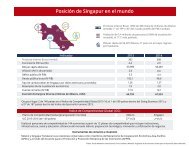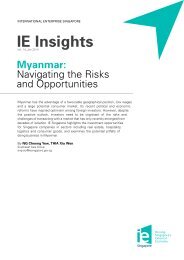basic-guide-to-exporting_Latest_eg_main_086196
basic-guide-to-exporting_Latest_eg_main_086196
basic-guide-to-exporting_Latest_eg_main_086196
Create successful ePaper yourself
Turn your PDF publications into a flip-book with our unique Google optimized e-Paper software.
Drawing ConclusionsAfter analyzing the data, you may conclude that your marketing resources would beapplied more effectively <strong>to</strong> a few select countries. In general, if your company is new<strong>to</strong> <strong>exporting</strong>, then efforts should be directed <strong>to</strong> fewer than 10 markets. Exporting<strong>to</strong> a manageable number of countries allows you <strong>to</strong> focus your resources withoutjeopardizing your domestic sales efforts. Your company’s internal resources shoulddetermine what choices you make. The U.S. government, though, has programs thatcan assist you with <strong>exporting</strong> <strong>to</strong> multiple markets within the same r<strong>eg</strong>ion. The U.S.Commercial Service, for example, has r<strong>eg</strong>ional export promotion programs in Asia,Europe, the Middle East, and the Americas, in addition <strong>to</strong> country- and industryspecificresources.Sources of Market ResearchMany domestic and international sources of information concerning internationalmarkets are available. This section describes the market research sources that havebeen mentioned, as well as some additional ones. Because so many research sourcesexist, your company may wish <strong>to</strong> seek advice from your local U.S. Commercial Serviceoffice <strong>to</strong> find the best and most current information.Research sources range from simple trade statistics, <strong>to</strong> in-depth market surveys,<strong>to</strong> firsthand interviews with public- and private-sec<strong>to</strong>r experts. Trade statisticsindicate <strong>to</strong>tal exports or imports by country and by product. They allow you <strong>to</strong>compare the size of the market for a product in various countries. Some statistics alsoreflect the U.S. share of the <strong>to</strong>tal market in a country in order <strong>to</strong> gauge the overallcompetitiveness of U.S. producers. By looking at statistics over several years, you candetermine which markets are growing and which are shrinking for your product.Market surveys provide a narrative description and assessment of particular markets,along with relevant statistics. The reports are often based on original researchconducted in the countries studied and may include specific information on bothbuyers and competi<strong>to</strong>rs.One of the best sources of information is personal interviews with private andgovernment officials and experts. A surprisingly large number of people in both thepublic and private sec<strong>to</strong>rs are available <strong>to</strong> assist you in any aspect of internationalmarket research. Either in face-<strong>to</strong>-face interviews or by telephone, these individualscan provide a wealth of market research information.Other sources of market research expertise include local chambers of commerce,world trade centers, or clubs and trade associations. Many state governments<strong>main</strong>tain active export promotion offices. In the federal government, industry andcommodity experts are available through the U.S. Departments of Commerce, State,and Agriculture and through the U.S. Small Business Administration (SBA).36U.S. Commercial Service • A Basic Guide <strong>to</strong> Exporting





